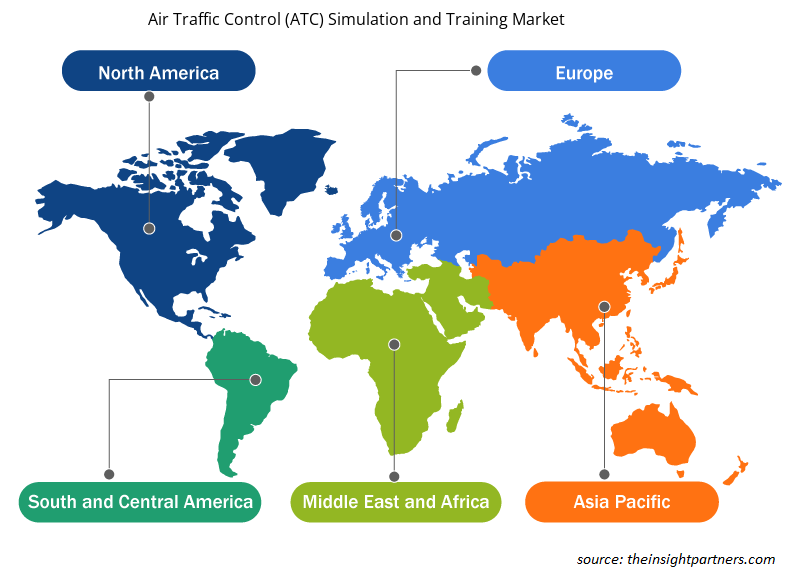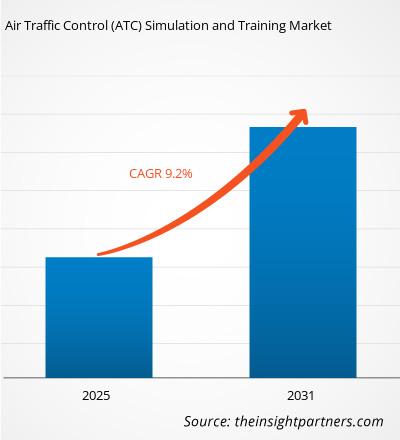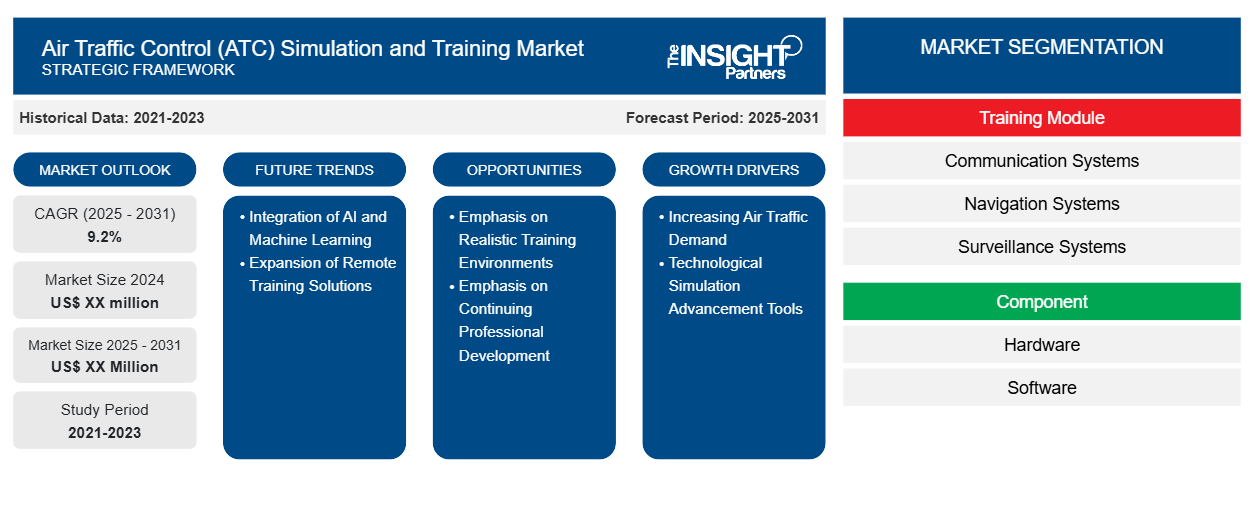Der Markt für Simulation und Training zur Flugsicherung (ATC) wird voraussichtlich von 2023 bis 2031 eine durchschnittliche jährliche Wachstumsrate (CAGR) von 9,2 % verzeichnen, wobei die Marktgröße von XX Millionen US-Dollar im Jahr 2023 auf XX Millionen US-Dollar im Jahr 2031 wachsen wird.
Der Bericht ist nach Trainingsmodulen (Kommunikationssysteme, Navigationssysteme, Überwachungssysteme, Automatisierungssysteme) segmentiert. Der Bericht enthält außerdem Analysen basierend auf den Komponenten (Hardware, Software). Der Bericht enthält außerdem Analysen basierend auf der Anwendung (kommerziell, militärisch). Die globale Analyse ist weiter auf regionaler Ebene und nach wichtigen Ländern aufgeschlüsselt. Der Bericht bietet den Wert in USD für die oben genannten Analysen und Segmente.
Zweck des Berichts
Der Bericht „Air Traffic Control (ATC) Simulation and Training Market“ von The Insight Partners zielt darauf ab, die aktuelle Situation und das zukünftige Wachstum sowie die wichtigsten Antriebsfaktoren, Herausforderungen und Chancen zu beschreiben. Dies wird verschiedenen Geschäftspartnern Einblicke geben, wie zum Beispiel:
- Technologieanbieter/-hersteller: Um die sich entwickelnde Marktdynamik zu verstehen und die potenziellen Wachstumschancen zu kennen, damit sie fundierte strategische Entscheidungen treffen können.
- Investoren: Durchführung einer umfassenden Trendanalyse hinsichtlich der Marktwachstumsrate, der finanziellen Marktprognosen und der Chancen entlang der Wertschöpfungskette.
- Regulierungsbehörden: Sie regulieren Richtlinien und polizeiliche Maßnahmen auf dem Markt mit dem Ziel, Missbrauch zu minimieren, das Vertrauen der Anleger zu bewahren und die Integrität und Stabilität des Marktes aufrechtzuerhalten.
Marktsegmentierung für Simulation und Training zur Flugsicherung (ATC)
Trainingsmodul
- Kommunikationssysteme
- Navigationssysteme
- Überwachungssysteme
- Automatisierungssysteme
Komponente
- Hardware
- Software
Anwendung
- Kommerziell
- Militär
Geographie
- Nordamerika
- Europa
- Asien-Pazifik
- Süd- und Mittelamerika
- Naher Osten und Afrika
Geographie
- Nordamerika
- Europa
- Asien-Pazifik
- Süd- und Mittelamerika
- Naher Osten und Afrika
Passen Sie diesen Bericht Ihren Anforderungen an
Sie erhalten kostenlos individuelle Anpassungen an jedem Bericht, einschließlich Teilen dieses Berichts oder einer Analyse auf Länderebene, eines Excel-Datenpakets sowie tolle Angebote und Rabatte für Start-ups und Universitäten.
- Holen Sie sich die wichtigsten Markttrends aus diesem Bericht.Dieses KOSTENLOSE Beispiel umfasst eine Datenanalyse von Markttrends bis hin zu Schätzungen und Prognosen.
Wachstumstreiber auf dem Markt für Flugsicherungssimulation und -training
- Steigende Nachfrage im Flugverkehr: Große Flugverkehrsmengen schaffen eine enorme Nachfrage nach Simulation und Training der Flugsicherung. Bei zunehmendem Flugverkehr müssen Flugzeuge von entsprechend ausgebildeten Fluglotsen gesteuert werden, damit die Bewegung der Flugzeuge sehr effizient und ohne Risiko erfolgt. Geschieht dies nicht, können die Flugzeugbewegungen unkontrollierbar werden. Dies führt zu Investitionen in fortschrittliche Simulations- und Trainingslösungen.
- Tools zur technologischen Verbesserung der Simulation: Verbesserungen bei Simulationstechnologien – insbesondere virtuelle Realität und künstliche Intelligenz – haben die Standards effektiver Schulungsprogramme für Fluglotsen verbessert. Die Technologien bieten eine Umgebung mit nahezu simulationsähnlichem Material für die Ausbildung von Fluglotsen, um bessere Lernergebnisse zu erzielen und die Effizienz und Effektivität zu verbessern.
Zukünftige Trends auf dem Markt für Flugsicherungssimulation und -training
- Integration von KI und maschinellem Lernen: Es besteht eine hervorragende Aussicht, KI und maschinelles Lernen in die Simulationsumgebungen der Flugsicherungsausbildung zu integrieren. Solche Technologien können adaptive Lernumgebungen aufbauen, die die Erfahrung auf den einzelnen Lernenden zuschneiden und sowohl den Erwerb als auch die Beibehaltung von Fähigkeiten maximieren.
- Ausbau von Remote-Trainingslösungen: Die COVID-19-Situation hat den Trend zu Remote-Trainingslösungen ausgelöst; dies wird die Wachstumschancen des ATC-Simulationsmarktes steigern. Online-Trainingsmodule und virtuelle Simulationen können den Zugang und die Flexibilität von Trainings verbessern und gleichzeitig Kosten für die an Trainings beteiligten Organisationen sparen.
Marktchancen für Flugsicherungssimulation und -training
- Betonung realistischer Trainingsumgebungen: Noch wichtiger ist jedoch die Konzentration auf ultrarealistische Trainingsumgebungen, die in den ultimativ realistischen Szenarien ihren Höhepunkt erreichen. Es werden computergestützte Simulationen, sogar mit anspruchsvoller Grafik und Echtzeit-Datenintegration, eingesetzt, damit die Auszubildenden die anstrengenden Komplexitäten der Flugverkehrskontrolle in einer sicheren Umgebung erleben können.
- Schwerpunkt auf kontinuierlicher beruflicher Entwicklung: Der Markt für ATC-Simulation und -Schulung erkennt zunehmend die Bedeutung kontinuierlicher beruflicher Entwicklung. Kontinuierliche Schulungsprogramme mit Simulationstechnologie werden ebenfalls zur Norm, damit Fluglotsen effektiv bleiben und über die neuesten Verfahren und anderen Technologien auf dem Laufenden sind.
Regionale Einblicke in den Markt für Flugsicherungssimulation und -training
Die regionalen Trends und Faktoren, die den Markt für Simulation und Training der Flugsicherung (ATC) während des Prognosezeitraums beeinflussen, wurden von den Analysten von Insight Partners ausführlich erläutert. In diesem Abschnitt werden auch Marktsegmente und Geografien für Simulation und Training der Flugsicherung (ATC) in Nordamerika, Europa, im asiatisch-pazifischen Raum, im Nahen Osten und Afrika sowie in Süd- und Mittelamerika erörtert.

- Erhalten Sie regionale Daten zum Markt für Flugsicherungssimulation und -training
Umfang des Marktberichts zur Simulation und Schulung der Flugsicherung (ATC)
| Berichtsattribut | Details |
|---|---|
| Marktgröße im Jahr 2024 | XX Millionen US-Dollar |
| Marktgröße bis 2031 | XX Millionen US-Dollar |
| Globale CAGR (2024 - 2031) | 9,2 % |
| Historische Daten | 2021-2023 |
| Prognosezeitraum | 2025–2031 |
| Abgedeckte Segmente | Nach Trainingsmodul
|
| Abgedeckte Regionen und Länder | Nordamerika
|
| Marktführer und wichtige Unternehmensprofile |
|
Dichte der Marktteilnehmer für Simulation und Training zur Flugsicherung (ATC): Auswirkungen auf die Geschäftsdynamik verstehen
Der Markt für Simulation und Training im Bereich Flugsicherung (ATC) wächst rasant. Dies wird durch die steigende Nachfrage der Endnutzer aufgrund von Faktoren wie sich entwickelnden Verbraucherpräferenzen, technologischen Fortschritten und einem größeren Bewusstsein für die Vorteile des Produkts vorangetrieben. Mit der steigenden Nachfrage erweitern Unternehmen ihr Angebot, entwickeln Innovationen, um die Bedürfnisse der Verbraucher zu erfüllen, und nutzen neue Trends, was das Marktwachstum weiter ankurbelt.
Die Marktteilnehmerdichte bezieht sich auf die Verteilung der Firmen oder Unternehmen, die in einem bestimmten Markt oder einer bestimmten Branche tätig sind. Sie gibt an, wie viele Wettbewerber (Marktteilnehmer) in einem bestimmten Marktraum im Verhältnis zu seiner Größe oder seinem gesamten Marktwert präsent sind.
Die wichtigsten Unternehmen auf dem Markt für Flugsicherungssimulation und -training sind:
- Adacel Technologies Limited
- Advanced Simulation Technology Inc.
- Edda Systems AS
- EIZO Corporation
- Global ATS Ltd
Haftungsausschluss : Die oben aufgeführten Unternehmen sind nicht in einer bestimmten Reihenfolge aufgeführt.

- Überblick über die wichtigsten Akteure auf dem Markt für Flugsicherungssimulation und -training
Wichtige Verkaufsargumente
- Umfassende Abdeckung: Der Bericht deckt die Analyse von Produkten, Diensten, Typen und Endbenutzern des Marktes für Flugsicherungssimulation und -training (ATC) umfassend ab und bietet einen ganzheitlichen Überblick.
- Expertenanalyse: Der Bericht basiert auf dem umfassenden Verständnis von Branchenexperten und Analysten.
- Aktuelle Informationen: Der Bericht stellt durch die Abdeckung aktueller Informationen und Datentrends Geschäftsrelevanz sicher.
- Anpassungsoptionen: Dieser Bericht kann angepasst werden, um spezifische Kundenanforderungen zu erfüllen und die Geschäftsstrategien optimal anzupassen.
Der Forschungsbericht zum Markt für Simulation und Training der Flugsicherung (ATC) kann daher dabei helfen, die Branchensituation und Wachstumsaussichten zu entschlüsseln und zu verstehen. Obwohl es einige berechtigte Bedenken geben kann, überwiegen die allgemeinen Vorteile dieses Berichts tendenziell die Nachteile.
- Historische Analyse (2 Jahre), Basisjahr, Prognose (7 Jahre) mit CAGR
- PEST- und SWOT-Analyse
- Marktgröße Wert/Volumen – Global, Regional, Land
- Branchen- und Wettbewerbslandschaft
- Excel-Datensatz
Aktuelle Berichte
Erfahrungsberichte
Grund zum Kauf
- Fundierte Entscheidungsfindung
- Marktdynamik verstehen
- Wettbewerbsanalyse
- Kundeneinblicke
- Marktprognosen
- Risikominimierung
- Strategische Planung
- Investitionsbegründung
- Identifizierung neuer Märkte
- Verbesserung von Marketingstrategien
- Steigerung der Betriebseffizienz
- Anpassung an regulatorische Trends





















 Kostenlose Probe anfordern für - Markt für Flugsicherungssimulation und -training
Kostenlose Probe anfordern für - Markt für Flugsicherungssimulation und -training